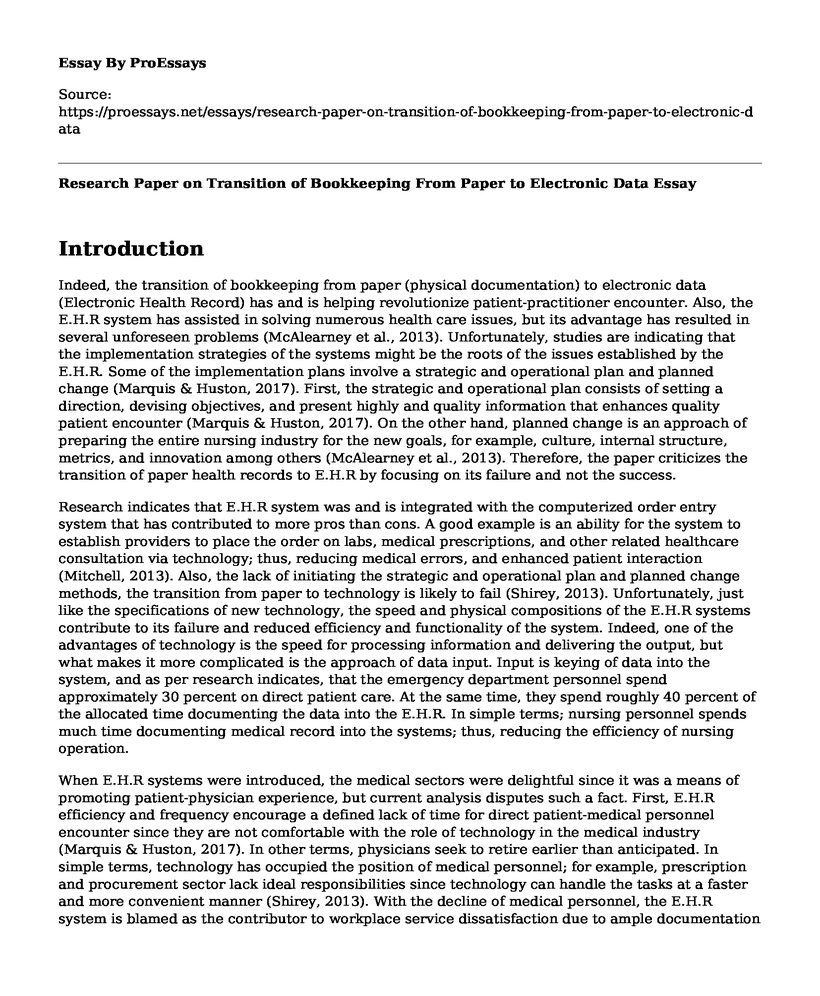Introduction
Indeed, the transition of bookkeeping from paper (physical documentation) to electronic data (Electronic Health Record) has and is helping revolutionize patient-practitioner encounter. Also, the E.H.R system has assisted in solving numerous health care issues, but its advantage has resulted in several unforeseen problems (McAlearney et al., 2013). Unfortunately, studies are indicating that the implementation strategies of the systems might be the roots of the issues established by the E.H.R. Some of the implementation plans involve a strategic and operational plan and planned change (Marquis & Huston, 2017). First, the strategic and operational plan consists of setting a direction, devising objectives, and present highly and quality information that enhances quality patient encounter (Marquis & Huston, 2017). On the other hand, planned change is an approach of preparing the entire nursing industry for the new goals, for example, culture, internal structure, metrics, and innovation among others (McAlearney et al., 2013). Therefore, the paper criticizes the transition of paper health records to E.H.R by focusing on its failure and not the success.
Research indicates that E.H.R system was and is integrated with the computerized order entry system that has contributed to more pros than cons. A good example is an ability for the system to establish providers to place the order on labs, medical prescriptions, and other related healthcare consultation via technology; thus, reducing medical errors, and enhanced patient interaction (Mitchell, 2013). Also, the lack of initiating the strategic and operational plan and planned change methods, the transition from paper to technology is likely to fail (Shirey, 2013). Unfortunately, just like the specifications of new technology, the speed and physical compositions of the E.H.R systems contribute to its failure and reduced efficiency and functionality of the system. Indeed, one of the advantages of technology is the speed for processing information and delivering the output, but what makes it more complicated is the approach of data input. Input is keying of data into the system, and as per research indicates, that the emergency department personnel spend approximately 30 percent on direct patient care. At the same time, they spend roughly 40 percent of the allocated time documenting the data into the E.H.R. In simple terms; nursing personnel spends much time documenting medical record into the systems; thus, reducing the efficiency of nursing operation.
When E.H.R systems were introduced, the medical sectors were delightful since it was a means of promoting patient-physician experience, but current analysis disputes such a fact. First, E.H.R efficiency and frequency encourage a defined lack of time for direct patient-medical personnel encounter since they are not comfortable with the role of technology in the medical industry (Marquis & Huston, 2017). In other terms, physicians seek to retire earlier than anticipated. In simple terms, technology has occupied the position of medical personnel; for example, prescription and procurement sector lack ideal responsibilities since technology can handle the tasks at a faster and more convenient manner (Shirey, 2013). With the decline of medical personnel, the E.H.R system is blamed as the contributor to workplace service dissatisfaction due to ample documentation as well as leadership burden. Ideally, since most of the health care sectors do not promote the use of strategic and operational planning and planned change theories, the E.H.R has become a discouraging agent to the medical personnel.
Conclusion
To conclude, it is ideal that E.H.R. systems transition from paper documentation has brought lots of changes in the medical industry, but not all physicians agree to such elements. Indeed, it has and is affecting the norms of therapeutic approach, for example, the allocated period for documenting the data into the system. Research indicated that it takes 40 percent of the allocated time for emergency personnel to key in the information, 10 percent more than when manual documentation is done. Finally, it affects medical personnel performance by discouraging them and promoting their early retirement from service.
References
Marquis, B., & Huston, C. (2017). Leadership roles and management functions in nursing: Theory and application (9th ed.). Philadelphia: PA: Lippincott, Williams & Wilkins.
McAlearney, A., Terris, D., Hardacre, J., Spurgeon, P., Brown, C., Baumgart, A., et al. (2013). Organizational coherence in health care organizations: conceptual guidance to facilitate quality improvement and organizational change. Qual Manag Health Care, 22(2):86-99. doi: 10.1097/QMH.0b013e31828bc37d.
Mitchell, G. (2013). Selecting the best theory to implement planned change. Nursing Management - UK, 20(1), 32-37. doi: 10.7748/nm2013.04.20.1.32.e1013.
Shirey, M. (2013). Lewin's Theory of Planned Change as a strategic resource. The Journal of Nursing Administration, 43(2), 69-72. doi:10.1097/NNA.0b013e31827f20a9.
Cite this page
Research Paper on Transition of Bookkeeping From Paper to Electronic Data. (2022, Dec 12). Retrieved from https://proessays.net/essays/research-paper-on-transition-of-bookkeeping-from-paper-to-electronic-data
If you are the original author of this essay and no longer wish to have it published on the ProEssays website, please click below to request its removal:
- Argumentative Essay on Patients' Confidentiality in Healthcare
- Primary and Secondary Goals of the United States Energy Policy Essay
- The Legality and Ethics of the Use of Abortion Pill in Quebec - Essay Sample
- Research Paper on Multicultural Assessment and Intervention Plan
- Essay on Sensors and Sensory Technology: A Human Perception Guide
- Evidence-Based Practice for Type 2 Diabetes Care - Research Paper
- Free Report on Navigating Gender Transition: Challenges and Considerations in Pediatric Care







